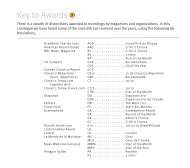MENDELSSOHN - Bis
MENDELSSOHN - Bis
MENDELSSOHN - Bis
You also want an ePaper? Increase the reach of your titles
YUMPU automatically turns print PDFs into web optimized ePapers that Google loves.
finale of this three-movement sym phony is lively and contains concise themes that<br />
are treated in a fugal manner, play fully and virtuosically.<br />
The extreme rapidity with which the twelve-year-old Mendelssohn worked is<br />
de monstrat ed well by the fact that the String Symphony No. 5 was completed on<br />
15th September 1821, just ten days after No. 4. The first movement is very rich;<br />
its themes (ornamented by trills) and its unexpected changes of course borrow<br />
many features from Wilhelm Friedemann Bach. The slow movement is a genuine<br />
gem of great delicacy, full of folk-like sweetness. Like the Fourth, the Fifth String<br />
Sym phony has three movements; it ends with a Presto in which vitality triumphs<br />
and where the unexpected key-changes with ritardandi, pauses and restarts con -<br />
stantly en liven the music.<br />
In the String Symphony No. 6 (autumn 1821) Mendelssohn’s individual per -<br />
son al ity is more in evidence. The piece shows a surprising maturity even though<br />
the style and themes are still very much in the spirit of Mozart – Mendelssohn<br />
was certainly aware of this, and it cannot be termed a fault. Here we find plenty<br />
of repeated notes, clear bass lines and lyrical second ary themes which readily re -<br />
mind us of the Vienn ese classicists. The two trio sections of the minuet lend the<br />
dance both nostalgia and enchant ment. The finale is a more fully developed<br />
structure, al though here too there are hints of Mozart and the early works of Beet -<br />
hoven.<br />
In the String Symphony No. 7 (1821–22) Mendelssohn plays with his pre de -<br />
cessors’ models and creates a multifaceted mosaic. Now he is fully in control of<br />
his material. The opening Allegro is rather Mozartian, but in the trio he finds his<br />
own paths to explore. He has developed his use of counter point, and in the finale<br />
he writes a large-scale fugue.<br />
On 27th November 1822 Mendelssohn completed his String Symphony No. 8<br />
in D major. Here he has taken a decisive step forwards; with a work lasting more<br />
33








